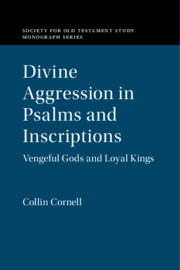Book contents
- Divine Aggression in Psalms and Inscriptions
- Society for Old Testament Study Monograph Series
- Divine Aggression in Psalms and Inscriptions
- Copyright page
- Contents
- Figures and Tables
- Translations
- Acknowledgments
- Author’s Note on the Translations
- 1 Divine Aggression in Comparative Perspective
- 2 Divine Aggression in Royal Inscriptions
- 3 Divine Aggression in Select Royal Psalms
- 4 Divine Aggression in Royal Psalms of Defeat
- 5 Divine Aggression in Prophetic Texts of Defeat
- 6 Conclusions and Implications
- Bibliography
- Bible Index
- Subject Index
- References
Bibliography
Published online by Cambridge University Press: 16 October 2020
- Divine Aggression in Psalms and Inscriptions
- Society for Old Testament Study Monograph Series
- Divine Aggression in Psalms and Inscriptions
- Copyright page
- Contents
- Figures and Tables
- Translations
- Acknowledgments
- Author’s Note on the Translations
- 1 Divine Aggression in Comparative Perspective
- 2 Divine Aggression in Royal Inscriptions
- 3 Divine Aggression in Select Royal Psalms
- 4 Divine Aggression in Royal Psalms of Defeat
- 5 Divine Aggression in Prophetic Texts of Defeat
- 6 Conclusions and Implications
- Bibliography
- Bible Index
- Subject Index
- References
Summary

- Type
- Chapter
- Information
- Divine Aggression in Psalms and InscriptionsVengeful Gods and Loyal Kings, pp. 215 - 237Publisher: Cambridge University PressPrint publication year: 2020

